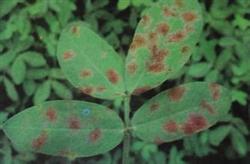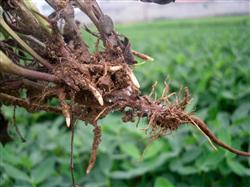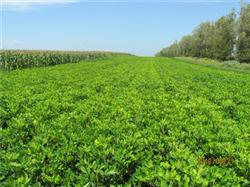Simple Identification of Peanut Leaf Blight

There are many causes of peanut leaf blight, but it can be divided into two categories: infectious diseases and non-infectious diseases. Generally speaking, the latter is difficult to control with pesticides. The author has personally seen the scene of farmers using carbendazim to control peanuts after sunburn, which shows that the types of peanut leaf blight can not be correctly identified, which will inevitably affect the correct application of control techniques. After on-the-spot observation, the common symptoms of peanut leaf blight were briefly described. 1 non-infectious leaf blight 1) sunburn. It often occurs in summer, when the temperature suddenly rises to more than 35 ℃, which is easy to occur in dry and hot wind weather. The occurrence range is large, the area is wide, and it is often common in an area. For example, this phenomenon occurred in Linshu County in 1999. Observe a peanut, the leaves that are exposed to direct sunlight are dry, and the leaves that are out of direct sunlight behave normally. 2) waste gas pollution. Often after rain, the fields around chemical plants (especially phosphate fertilizer plants) and those far away from chemical plants behave normally. Observation of a pile of peanuts, old leaves, tender leaves, stems and other aboveground parts will show dry. It is generally caused by acid rain containing sulfur and fluorine. 3) Pesticide damage. It often occurs after pesticide application, because crops are sensitive to certain drugs and the concentration of the solution is too high in the process of controlling peanut diseases and insect pests. In addition, herbicide damage caused by herbicides is also common when sprayers that have been sprayed with herbicides are not cleaned. The injured fields were limited to the fields that had been treated, while the other fields with drugs behaved normally. (2) compared with non-infectious leaf blight, infectious leaf blight is not formed in a short time, but gradually formed. 1) Leaf spot. Including brown spot and black spot. What they have in common is that they all occur in the middle and later stages of peanut growth. It was mainly harmful to the leaves, and the lower old leaves first fell ill and gradually spread upward. The initial brown needle-sized spot gradually enlarged into a round spot. Under wet conditions, the disease spots produce grayish-brown mildew, and the disease spots become irregular spots, causing fallen leaves. 2) Peanut net spot. It is a disease that has been aggravated in recent years. There are two types, namely, speckle type and speckle type. The common feature is that under the condition of high humidity, small black spots appeared on the leaves at first, and then expanded into irregular black-brown disease spots with reticular edges, resulting in a large number of fallen leaves of peanuts in the middle and later stages. In addition, peanut root rot, stem rot, white silk disease, bacterial wilt and so on also lead to peanut leaf blight, often the whole plant withered. But these diseases generally occur less frequently.
- Prev

How to identify peanut root rot?
The incidence of peanut root rot is the most serious in the flowering and fruiting period. It mainly harms the root of peanut. After peanut infection, there were yellowish-brown infiltrating disease spots in the root neck, and then the disease gradually became dark brown. The main root of the diseased plant is wet-rotted, the root cortex turns brown and rotten, it is easy to peel off, there is no lateral root, or the lateral root is few and short, and the main root is like a rat tail.
- Next

What is the principle of fertilizing peanuts?
The main results are as follows: (1) Farm manure is the main and chemical fertilizer is the auxiliary. In China, peanuts are mostly planted in hilly areas, with thin soil layer and low fertility. Farm manure is mainly organic fertilizer, which is rich in nutrients, which can improve soil, fertilize and fertilize the soil for a long time. Chemical fertilizer is a quick-acting fertilizer, although it also contains the nutrients needed by peanuts, but with.
Related
- The first cup of black tea in spring, the flavor and history of tea gardens in Kenya, Africa
- The computer can not only choose potatoes, but also grow tea rice. AI will grow winter oolong tea champion.
- It is not only the inflated tea bitten by insects, but also engraved with the four seasons tea in Beipu.
- The Oriental Beauty Tea Festival in Zhuxian County takes the stage at the weekend to experience the plus-size feast of oil tea.
- & quot; Oriental Beauty Tea & Exploration of Emei in Hsinchu, the hometown of quot;
- The new variety of strawberry "Tainong 1" dessert is the first choice with mellow aroma. Crimson gorgeous
- History of Tea in Taiwan: from Wild Inner Mountain to Export Tea Garden
- Two types of Taiwan Oriental Beauty Black Tea won the British three-Star Award for Childhood Tea Xiang Zhang Jiaqi changed from pilot to champion tea maker.
- Banana species and varieties: the planting history of Taiwan Xianren banana and dwarf banana is long, is banana disease resistant?
- Coffee planting Technology: Qianjie Coffee from Seedling to harvesting

